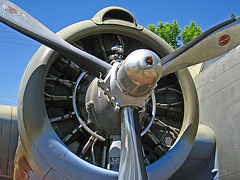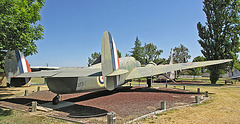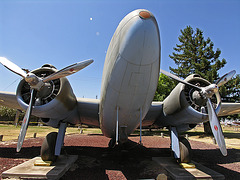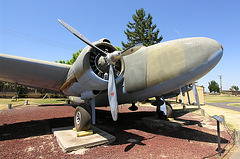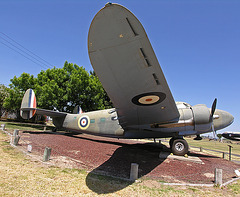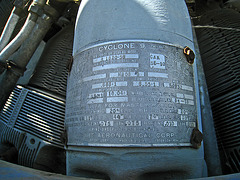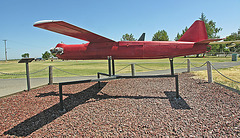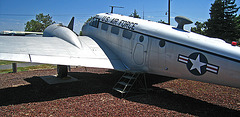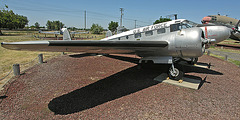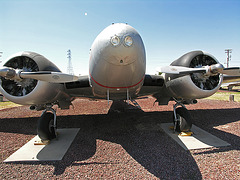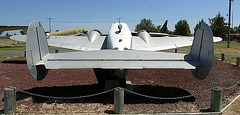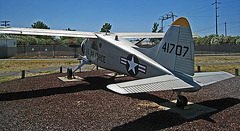
Castle Air Museum
A visit to the Castle Air Museum in Atwater, California.
Lockheed C-56 Lodestar (3003)
| |
|
This aircraft is one of 29 Model 18 Lodestars ordered by South African Airways in the late 1930s. War broke out before they were delivered in 1940-41 and all but one went straight to the South African Air Force where they were used as intermediate range personnel transports, carrying 14 passengers and a crew of 3. The Lodestars were assigned to 5 Wing based at Air Force Station Germiston. It was returned to South African Airways in 1944, registered as ZS-ASU and named "Piet Retief." It was withdrawn from SAA service in October 1950 and sold to East African Airways. The USAAF operated Lodestars during World War II, some taken over from civil airlines as C-56 and C-57, some purchased new as C-60s. The US Navy also purchased some under designation R-50. The aircraft at Castle Air Museum displays WWII markings of the South African Air Force.
Lockheed C-56 Lodestar (8377)
| |
|
This aircraft is one of 29 Model 18 Lodestars ordered by South African Airways in the late 1930s. War broke out before they were delivered in 1940-41 and all but one went straight to the South African Air Force where they were used as intermediate range personnel transports, carrying 14 passengers and a crew of 3. The Lodestars were assigned to 5 Wing based at Air Force Station Germiston. It was returned to South African Airways in 1944, registered as ZS-ASU and named "Piet Retief." It was withdrawn from SAA service in October 1950 and sold to East African Airways. The USAAF operated Lodestars during World War II, some taken over from civil airlines as C-56 and C-57, some purchased new as C-60s. The US Navy also purchased some under designation R-50. The aircraft at Castle Air Museum displays WWII markings of the South African Air Force.
Lockheed C-56 Lodestar (8376)
| |
|
This aircraft is one of 29 Model 18 Lodestars ordered by South African Airways in the late 1930s. War broke out before they were delivered in 1940-41 and all but one went straight to the South African Air Force where they were used as intermediate range personnel transports, carrying 14 passengers and a crew of 3. The Lodestars were assigned to 5 Wing based at Air Force Station Germiston. It was returned to South African Airways in 1944, registered as ZS-ASU and named "Piet Retief." It was withdrawn from SAA service in October 1950 and sold to East African Airways. The USAAF operated Lodestars during World War II, some taken over from civil airlines as C-56 and C-57, some purchased new as C-60s. The US Navy also purchased some under designation R-50. The aircraft at Castle Air Museum displays WWII markings of the South African Air Force.
Lockheed C-56 Lodestar (8375)
| |
|
This aircraft is one of 29 Model 18 Lodestars ordered by South African Airways in the late 1930s. War broke out before they were delivered in 1940-41 and all but one went straight to the South African Air Force where they were used as intermediate range personnel transports, carrying 14 passengers and a crew of 3. The Lodestars were assigned to 5 Wing based at Air Force Station Germiston. It was returned to South African Airways in 1944, registered as ZS-ASU and named "Piet Retief." It was withdrawn from SAA service in October 1950 and sold to East African Airways. The USAAF operated Lodestars during World War II, some taken over from civil airlines as C-56 and C-57, some purchased new as C-60s. The US Navy also purchased some under designation R-50. The aircraft at Castle Air Museum displays WWII markings of the South African Air Force.
Lockheed C-56 Lodestar (8374)
| |
|
This aircraft is one of 29 Model 18 Lodestars ordered by South African Airways in the late 1930s. War broke out before they were delivered in 1940-41 and all but one went straight to the South African Air Force where they were used as intermediate range personnel transports, carrying 14 passengers and a crew of 3. The Lodestars were assigned to 5 Wing based at Air Force Station Germiston. It was returned to South African Airways in 1944, registered as ZS-ASU and named "Piet Retief." It was withdrawn from SAA service in October 1950 and sold to East African Airways. The USAAF operated Lodestars during World War II, some taken over from civil airlines as C-56 and C-57, some purchased new as C-60s. The US Navy also purchased some under designation R-50. The aircraft at Castle Air Museum displays WWII markings of the South African Air Force.
Lockheed C-56 Lodestar (8373)
| |
|
|
This aircraft is one of 29 Model 18 Lodestars ordered by South African Airways in the late 1930s. War broke out before they were delivered in 1940-41 and all but one went straight to the South African Air Force where they were used as intermediate range personnel transports, carrying 14 passengers and a crew of 3. The Lodestars were assigned to 5 Wing based at Air Force Station Germiston. It was returned to South African Airways in 1944, registered as ZS-ASU and named "Piet Retief." It was withdrawn from SAA service in October 1950 and sold to East African Airways. The USAAF operated Lodestars during World War II, some taken over from civil airlines as C-56 and C-57, some purchased new as C-60s. The US Navy also purchased some under designation R-50. The aircraft at Castle Air Museum displays WWII markings of the South African Air Force.
Lockheed C-56 Lodestar (3007)
| |
|
This aircraft is one of 29 Model 18 Lodestars ordered by South African Airways in the late 1930s. War broke out before they were delivered in 1940-41 and all but one went straight to the South African Air Force where they were used as intermediate range personnel transports, carrying 14 passengers and a crew of 3. The Lodestars were assigned to 5 Wing based at Air Force Station Germiston. It was returned to South African Airways in 1944, registered as ZS-ASU and named "Piet Retief." It was withdrawn from SAA service in October 1950 and sold to East African Airways. The USAAF operated Lodestars during World War II, some taken over from civil airlines as C-56 and C-57, some purchased new as C-60s. The US Navy also purchased some under designation R-50. The aircraft at Castle Air Museum displays WWII markings of the South African Air Force.
Lockheed C-56 Lodestar (3006A)
| |
|
This aircraft is one of 29 Model 18 Lodestars ordered by South African Airways in the late 1930s. War broke out before they were delivered in 1940-41 and all but one went straight to the South African Air Force where they were used as intermediate range personnel transports, carrying 14 passengers and a crew of 3. The Lodestars were assigned to 5 Wing based at Air Force Station Germiston. It was returned to South African Airways in 1944, registered as ZS-ASU and named "Piet Retief." It was withdrawn from SAA service in October 1950 and sold to East African Airways. The USAAF operated Lodestars during World War II, some taken over from civil airlines as C-56 and C-57, some purchased new as C-60s. The US Navy also purchased some under designation R-50. The aircraft at Castle Air Museum displays WWII markings of the South African Air Force.
Kawasaki KAQ-1 Drone (8380)
| |
|
|
Produced in the 1950s, this is a radio-controlled unmanned miniature aircraft. It was launched from a ramp and recovered by parachute. It was used as a target for aintiaircraft gunners and air-to-missile training. It was also used for atmospheric research and reconnaissance.
Kawasaki KAQ-1 Drone (3010)
| |
|
|
Produced in the 1950s, this is a radio-controlled unmanned miniature aircraft. It was launched from a ramp and recovered by parachute. It was used as a target for aintiaircraft gunners and air-to-missile training. It was also used for atmospheric research and reconnaissance.
Kawasaki KAQ-1 Drone (3008)
| |
|
|
Produced in the 1950s, this is a radio-controlled unmanned miniature aircraft. It was launched from a ramp and recovered by parachute. It was used as a target for aintiaircraft gunners and air-to-missile training. It was also used for atmospheric research and reconnaissance.
Beech C-45 Expediter (3012)
| |
|
Built as the D-18 light commercial transport in 1940. Of the 4,500 built for the USAAF by 1945, 1,400 were built exclusively for transport use. Other versions included the AT-7 for navigation training, the AT-11 for bombardier and weapons training and the F-2 for photo reconnaissance. It is powered by two Pratt-Whitney engines and had a maximum speed of 220 MPH. It was also used by the Navy as the JRB (c-45) and SNB (AT-7/11). This C-45 at Castle Air Museum came from the Department of Agriculture.
Beech C-45 Expediter (8382)
| |
|
Built as the D-18 light commercial transport in 1940. Of the 4,500 built for the USAAF by 1945, 1,400 were built exclusively for transport use. Other versions included the AT-7 for navigation training, the AT-11 for bombardier and weapons training and the F-2 for photo reconnaissance. It is powered by two Pratt-Whitney engines and had a maximum speed of 220 MPH. It was also used by the Navy as the JRB (c-45) and SNB (AT-7/11). This C-45 at Castle Air Museum came from the Department of Agriculture.
Beech C-45 Expediter (8381)
| |
|
Built as the D-18 light commercial transport in 1940. Of the 4,500 built for the USAAF by 1945, 1,400 were built exclusively for transport use. Other versions included the AT-7 for navigation training, the AT-11 for bombardier and weapons training and the F-2 for photo reconnaissance. It is powered by two Pratt-Whitney engines and had a maximum speed of 220 MPH. It was also used by the Navy as the JRB (c-45) and SNB (AT-7/11). This C-45 at Castle Air Museum came from the Department of Agriculture.
Beech C-45 Expediter (8384)
| |
|
Built as the D-18 light commercial transport in 1940. Of the 4,500 built for the USAAF by 1945, 1,400 were built exclusively for transport use. Other versions included the AT-7 for navigation training, the AT-11 for bombardier and weapons training and the F-2 for photo reconnaissance. It is powered by two Pratt-Whitney engines and had a maximum speed of 220 MPH. It was also used by the Navy as the JRB (c-45) and SNB (AT-7/11). This C-45 at Castle Air Museum came from the Department of Agriculture.
Beech C-45 Expediter (8383)
| |
|
Built as the D-18 light commercial transport in 1940. Of the 4,500 built for the USAAF by 1945, 1,400 were built exclusively for transport use. Other versions included the AT-7 for navigation training, the AT-11 for bombardier and weapons training and the F-2 for photo reconnaissance. It is powered by two Pratt-Whitney engines and had a maximum speed of 220 MPH. It was also used by the Navy as the JRB (c-45) and SNB (AT-7/11). This C-45 at Castle Air Museum came from the Department of Agriculture.
DeHaviland-Canada L-20 Beaver (3014)
| |
|
Originally designed as a utility aircraft for service in Canada's rugged north, this plane was valued by both the U.S. Army and Air Force. The U.S. purchased some 980. It could be fitted with skis or floats and was used for observation and light transport duties. Though not very fast (155 MPH maximum), they were quick to get off the ground. A fully loaded L-20 could clear a 50 foot obstacle while using only 1,200 feet of runway. This plane at Castle Air Museum came from the Department of Agriculture.
DeHaviland-Canada L-20 Beaver (3013)
| |
|
Originally designed as a utility aircraft for service in Canada's rugged north, this plane was valued by both the U.S. Army and Air Force. The U.S. purchased some 980. It could be fitted with skis or floats and was used for observation and light transport duties. Though not very fast (155 MPH maximum), they were quick to get off the ground. A fully loaded L-20 could clear a 50 foot obstacle while using only 1,200 feet of runway. This plane at Castle Air Museum came from the Department of Agriculture.
Jump to top
RSS feed- Latest items - Subscribe to the latest items added to this album
- ipernity © 2007-2024
- Help & Contact
|
Club news
|
About ipernity
|
History |
ipernity Club & Prices |
Guide of good conduct
Donate | Group guidelines | Privacy policy | Terms of use | Statutes | In memoria -
Facebook
Twitter

